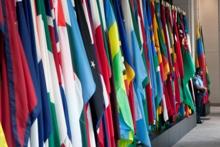BEIJING, Aug. 12 (Xinhua) — Newly released economic indicators fell short of market expectations, revealing that the Chinese economy still lacks momentum and downward pressure remains.
China’s value-added industrial output, which measures the final value of industrial production, expanded 6 percent year on year in July, down from 6.8 percent for June, the National Bureau of Statistics (NBS) said Wednesday.
The decline in output growth ended a steady recovery trend recorded in the second quarter of this year.
NBS statistician Jiang Yuan attributed the drop mainly to flagging external demand, a weak property sector and lowered production of some consumer goods, including automobiles and cigarettes.
Year-on-year growth in the first seven months stood at 6.3 percent, the same level as the growth for the first half of the year.
The NBS data only tracks the output of large Chinese companies with annual primary business revenues of more than 20 million yuan (3.16 million U.S. dollars).
Industrial output in China’s western regions increased by 7.9 percent in July, trailed by 7.4 percent in central areas and 6 percent in eastern regions.
Manufacturing output rose 6.6 percent, mining output added 5.6 percent, while that of the electricity, heating, gas and water sectors dropped 0.2 percent, the bureau said.
China’s fixed-asset investment, a major driver of growth, also witnessed slightly slower growth, with no sign of improvement for investment in property and infrastructure.
Retail sales held steady in July, as the growth rate was just 0.1 percentage point lower than a month ago.
Qu Hongbin, chief China economist at HSBC, said the data fell below general market expectations.
The declining output and investment growth showed the rebound in June was just temporary and pressure for growth was again on the rise, Qu said.
“With gloomy prospects for external demand, China will still need to rely on domestic demand to maintain steady growth, indicating that future monetary and fiscal policies should continue to be relaxed,” he said.
China’s exports dropped 0.9 percent from a year earlier in the first seven months, according to new customs data.
A research note from Minsheng Securities also said China’s growth is still facing huge pressure and the country needs to make more efforts to realize its goal of annual economic growth of around 7 percent.
China should take more pragmatic measures to stabilize growth, including further cuts in the reserve requirement ratio (RRR) and more targeted measures to reduce long-term interest rates, Minsheng said.
Qu added that the disappointing figures will also reinforce the market’s expectations for further depreciation of China’s currency, the yuan, posing risks of overcorrection in the exchange rate, which may lead to retaliation from other countries.
On Tuesday, China’s central bank changed the exchange rate formation system to take into consideration the closing rate of the inter-bank foreign exchange market on the previous day, as well as supply and demand in the market and price movements of major currencies.
The central parity rate of the yuan weakened by about 1.6 percent against the U.S. dollar Wednesday, following a 2-percent depreciation on Tuesday.
HSBC forecast an additional 25-basis-point interest rate cut and a 200-basis-point cut to the RRR in the second half to sustain growth.
The central bank has cut both interest rates and the RRR three times since the beginning of this year. Enditem
Source Xinhua















